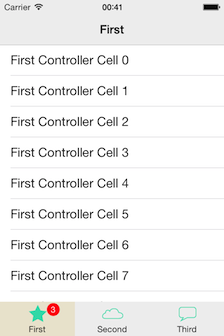RDVTabBarController
- Supports iPad and iPhone
- Supports landscape and portrait orientations
- Can be used inside UINavigationController
- Customizable badges
Installation
CocoaPods
If you're using CocoaPods, simply add pod 'RDVTabBarController' to your Podfile.
Drag & Drop
Add the items from RDVTabBarController directory to your project. If you don't have ARC enabled, you will need to set a -fobjc-arc compiler flag on the .m source files.
Example Usage
Initialize RDVTabBarController
The initialization is similar to the one for UITabBarController. Create an instance of the tabBarController and initialize its viewControllers.
UIViewController *firstViewController = [[RDVFirstViewController alloc] init];
UIViewController *firstNavigationController = [[UINavigationController alloc]
initWithRootViewController:firstViewController];
UIViewController *secondViewController = [[RDVSecondViewController alloc] init];
UIViewController *secondNavigationController = [[UINavigationController alloc]
initWithRootViewController:secondViewController];
UIViewController *thirdViewController = [[RDVThirdViewController alloc] init];
UIViewController *thirdNavigationController = [[UINavigationController alloc]
initWithRootViewController:thirdViewController];
RDVTabBarController *tabBarController = [[RDVTabBarController alloc] init];
[tabBarController setViewControllers:@[firstNavigationController, secondNavigationController,
thirdNavigationController]];
self.viewController = tabBarController;Customize RDVTabBarController
Each RDVTabBarItem has selectedBackground, unselectedBackground and corresponding properties for the icons: selectedImage and unselectedImage.
UIImage *finishedImage = [UIImage imageNamed:@"tabbar_selected_background"];
UIImage *unfinishedImage = [UIImage imageNamed:@"tabbar_normal_background"];
NSArray *tabBarItemImages = @[@"first", @"second", @"third"];
RDVTabBar *tabBar = [tabBarController tabBar];
[tabBar setFrame:CGRectMake(CGRectGetMinX(tabBar.frame), CGRectGetMinY(tabBar.frame), CGRectGetWidth(tabBar.frame), 63)];
NSInteger index = 0;
for (RDVTabBarItem *item in [[tabBarController tabBar] items]) {
[item setBackgroundSelectedImage:finishedImage withUnselectedImage:unfinishedImage];
UIImage *selectedimage = [UIImage imageNamed:[NSString stringWithFormat:@"%@_selected",
[tabBarItemImages objectAtIndex:index]]];
UIImage *unselectedimage = [UIImage imageNamed:[NSString stringWithFormat:@"%@_normal",
[tabBarItemImages objectAtIndex:index]]];
[item setFinishedSelectedImage:selectedimage withFinishedUnselectedImage:unselectedimage];
index++;
}Make the tab bar translucent
RDVTabBar has translucent property which determines how it is going to be handled.
RDVTabBar *tabBar = tabBarController.tabBar;
// After the tabBarController initialization
tabBar.translucent = YES;
// Customize the tabBar background
tabBar.backgroundView.backgroundColor = [UIColor colorWithRed:245/255.0
green:245/255.0
blue:245/255.0
alpha:0.9]];
// Inside the tabbed viewControllers
- (void)viewDidLoad {
[super viewDidLoad];
...
if (self.rdv_tabBarController.tabBar.translucent) {
CGFloat tabBarHeight = CGRectGetHeight(self.rdv_tabBarController.tabBar.frame);
UIEdgeInsets insets = UIEdgeInsetsMake(0, 0, tabBarHeight, 0);
self.tableView.contentInset = insets;
self.tableView.scrollIndicatorInsets = insets;
}
}
Requirements
- ARC
- iOS 5.0 or later
- Xcode 5
Contact
License
RDVTabBarController is available under the MIT license. See the LICENSE file for more info.

